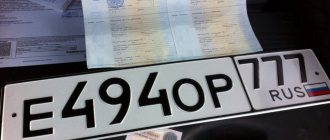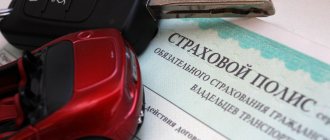List of documents
The number of documents that a driver constantly needs to carry with him is not that large. The list includes:
- Driver's license (valid).
- OSAGO/CASCO insurance policy, which after purchasing a car can only be obtained if you have a driver’s license, a registration certificate of the previous owner and a purchase and sale agreement. You can apply for a policy at any branch of the insurance company of the car owner’s choice. It is worth taking into account the fact that when applying for a policy outside your place of permanent residence, there may be no service in your city under the policy if there is no branch of the insurance company.
- A certificate of registration of a vehicle in the MREO of the State Traffic Safety Inspectorate can be obtained if you have a title, a document confirming the fact of ownership of the car, a policy and a driver’s license.
There are also some documents that you need to have with you in certain situations:
- If there is a trailer, the driver must have a registration certificate and an insurance policy for it. An endorsement on the driver's license indicating that the driver can drive with a trailer is also required.
- If the owner is engaged in the transportation of passengers on a commercial basis, then he also needs to carry a permit to carry out this activity in the vehicle. The same story applies to trucks with dangerous or large cargo, but in this case, in addition to the above documents, there must also be invoices for the cargo.
Duty
The driver must always have these documents with him. If he is not the owner of the car, then there must be either a power of attorney, or he must be included in the policy. An alternative is a policy “without restrictions”, but all other documents, i.e. certificate and license are still needed.
The driver is not obliged to carry the remaining documents with him and show them during a simple check either to the traffic police inspector or to representatives of other law enforcement agencies.
He may not even hand over the documents to the latter, but show them himself. Therefore, if the requirement for a technical inspection coupon (since without MOT you cannot get insurance, which, by the way, includes technical inspection data), a passport, PTS or other documents is not justified by any factors, then no one has the right to force them to be presented.
Other features of the document presentation process
The main rule to consider when meeting with law enforcement officials is politeness. Even if the driver films his communication with them on camera or records it on a voice recorder (which is sometimes necessary), you need to warn about this. There is no need to be rude in response to a careless traffic police officer, but filming or recording in such a situation is mandatory in order to further prove that you are right if problems arise.
If the traffic police inspector requires other documents, then the driver should not argue with him; he can calmly answer that they are not required by law. If, in the event of a conflict initiated by either party, a traffic police officer took into his car the documents presented to him by the driver and does not want to give them back, you need to call the police on 02, report where and which employees are breaking the law, then calmly wait for the situation to be resolved.
What can you carry?
The other day, one of my friends was stopped by traffic cops. He looked like he had been working only recently. Word by word, it came to document verification.
My friend's driver's license and insurance were fine. Suddenly the traffic cop asked him for his PTS.
I did not have this document with me. The traffic police officer wanted to make a remark, but at that moment his more experienced colleague approached. It turned out that according to the new rules, it is not at all necessary to carry a vehicle with you. You also do not need to take the car purchase and sale agreement with you.
Example 1: Sergei was stopped by traffic police officers while he was on his way to work. When checked, it turned out that he did not have a driver's license with him. Sergei was checked in the database, they found out that he had a license, and there were no fines against him. But because he left his license at home, a report was drawn up against him and a fine of 500 rubles was issued.
So that you have fewer questions, I decided to write this article.
Likewise, you no longer need to carry a power of attorney with you. If you give someone a car, then information about this person must be included in the OSAGO or CASCO policy.
The power of attorney was a completely meaningless document. It didn't even need to be notarized. It could be compiled by hand on any sheet of paper. After several million people voted on the Internet for its abolition, amendments were made to the law.
| Fine calculator for driving without an MTPL policy: | |
| What was the violation? | |
| Has 20 days passed since receiving the fine or drawing up the report? | |
PTS should always be kept at home. If you lose it, you will have to order a duplicate. This may create unnecessary problems when selling. Buyers will see that it is a duplicate and may suspect that the car is stolen. This is exactly what bank scammers do: they buy a car on credit and then sell it.
Experts and lawyers have also long proposed to cancel this document. Although if you decide to sell a car with someone else’s help, then a power of attorney will, of course, be needed. Only a notary must draw up and certify it.
You also need a notarized power of attorney if you are traveling abroad in someone else’s car.
Complete list of required driver documents
What documents must the seller provide before the purchase and sale transaction?
When transporting a group of children in an organized manner, the bus driver must have the following documents with him:
1) a driver’s license for the right to drive a vehicle of the appropriate category;
2) registration documents for this vehicle;
3) waybill;
4) an insurance policy for compulsory civil liability insurance of the vehicle owner;
5) copies of the following documents:
— traffic schedule and route diagrams approved by the head or official responsible for ensuring road safety, organization, or an authorized person of the charterer;
- a document containing the procedure for boarding children on the bus, established by the head or official responsible for ensuring road safety, an educational organization, an organization providing training, an organization carrying out educational activities, a medical organization or other organization, an individual entrepreneur carrying out organized transportation of a group children by bus (hereinafter referred to as the organization), or by the charterer, except for the case when the specified procedure for boarding children is contained in the charter agreement;
— decisions on assigning escort of buses by a vehicle (vehicles) of a unit of the State Traffic Inspectorate or notification of a negative decision based on the results of consideration of an application for such escort;
- a document containing information about the medical worker (last name, first name, patronymic, position), a copy of the license to carry out medical activities or a copy of the agreement with a medical organization or individual entrepreneur who has the appropriate license - in case of organized transportation of a group of children in intercity traffic by an organized transport convoy for more than 3 hours according to the traffic schedule;
Note. In information about a medical worker, it is advisable to indicate his contact phone number.
- a list of a set of food products (dry rations, bottled water) according to the assortment established by the Federal Service for Surveillance on Consumer Rights Protection and Human Welfare or its territorial administration - if children are on the route according to the traffic schedule for more than 3 hours;
- a list of appointed accompanying persons (indicating the last name, first name, patronymic of each accompanying person, his telephone number), a list of children (indicating the last name, first name, patronymic and age of each child) for the bus he drives, information about the numbering of buses when moving (when carrying out transportation by 2 or more buses).
Note. The number of accompanying persons per 1 bus is assigned based on their presence at each door of the bus, while one of the accompanying persons is responsible for the organized transportation of a group of children on the corresponding bus and coordinates the actions of the driver (drivers) and other accompanying persons on the specified bus.
If 2 or more buses are used to carry out the organized transportation of a group of children, the head or official responsible for ensuring road safety of the organization, and in the case of organized transportation of a group of children under a charter agreement, the charterer appoints a senior person responsible for the organized transportation of a group of children and coordination actions of drivers and those responsible for buses carrying out such transportation.
List of documents that the driver must have when traveling around Russia
Every driver who gets behind the wheel of a car must have 3 important documents with him.
- STS - certificate of state registration of the car (laminated card measuring 80 mm x 115 mm). Do not confuse this document with PTS. A vehicle passport indicates that the vehicle is legally located on the territory of the Russian Federation. You must have this document with you to register your car with the traffic police. You will also need a PTS to carry out transactions related to changing the owner of the car (this could be a sale, a gift). And to drive a car, you must have an STS with you - a document confirming the “registration” of the car in a specific region of the Russian Federation. It contains comprehensive information about the car and its owner.
- A driver's license is a document giving the driver the right to drive a vehicle of the specified category. If a driver gets behind the wheel without this document, he does not have the right to drive a car.
- OSAGO policy. Every driver must have this document with him. The MTPL policy acts as a guarantee of civil liability to other road users. If the driver is at fault for the accident, the insurance company will cover the damage to the victims based on this document. The driver must have an MTPL insurance policy with him also because the document guarantees the technically sound condition of the car. Without a diagnostic card, which replaced the maintenance coupon, it will not be possible to issue an MTPL.
The CASCO policy does not replace the MTPL policy. These are different documents. You may not have CASCO insurance, but you cannot drive a car without an MTPL policy. The CASCO policy insures your car and your health, and the MTPL policy insures the property and health of third parties who suffer due to your fault.
If the driver does not have at least one of these documents with him, the traffic police officer will have every right to issue a fine. The price tag in this case starts from 500 rubles. You can get away with a slight fright (if the inspector is in a good mood) if you forgot your MTPL policy at home (Clause 2 of Article 12.3 of the Administrative Code). More serious consequences await a driver who gets behind the wheel without a driver's license. This is punishable by clause 1 of Art. 12.7 of the Administrative Code in the form of a fine from 5,000 to 15,000 rubles. If you drive a car without any documents at all, you may be suspected of theft. Therefore, make a rule for yourself: when you get behind the wheel, you must check your documents, and only then can you start the car’s engine and drive off.
The driver who drives a company car must have additional documents with him: a waybill and a power of attorney from the company. When transporting imported goods, the driver must also carry customs documents.
Pre-trip and post-trip medical examination marks
Signs on the dashboard that every driver should know. There is an exclamation mark on the speedometer
Each institution that operates vehicles is required to conduct pre-trip and post-trip medical examinations of drivers. This responsibility is assigned to them in accordance with paragraph 1 of Article 20 and Article 23 of the Federal Law of December 10, 1995 No. 196-FZ “On Road Safety”. Let us note that the Ministry of Health of Russia, together with the Ministry of Transport of Russia, approved the Methodological Recommendations “On the organization of pre-trip medical examinations of vehicle drivers” (see letter of the Ministry of Health of Russia dated August 21, 2003 No. 2510/9468-03-32). This document regulates the procedure for conducting medical examinations of drivers and, first of all, should help the institution to properly organize this process.
A stamp is placed on the waybill indicating the date and exact time of the medical examination, the surname, initials and signature of the medical worker who conducted the examination. The stamp is placed only if there are no symptoms of the disease, the driver is drunk, etc.
Pre-trip medical examinations can only be carried out by personnel who have the appropriate certificate, as well as medical institutions with a license. This position is also confirmed by judicial practice (resolution of the Federal Antimonopoly Service of the Ural District dated August 1, 2005 No. F09-3196/05-S7).
Let us remind you that the absence of a stamp confirming the completion of a pre-trip inspection may be qualified as a violation of the law.
When is it necessary to fill out a waybill?
What documents are needed to obtain a TIN?
Let's consider article 6 of the federal law “Charter of road transport and urban ground electric transport”:
Article 6. Waybills 1. Mandatory details and the procedure for filling out waybills are approved by the federal executive body exercising the functions of developing state policy and legal regulation in the field of transport, in the manner established by the Government of the Russian Federation.
2. It is prohibited to transport passengers and luggage, cargo by buses, trams, trolleybuses, cars, trucks without issuing a waybill for the corresponding vehicle.
Pay attention to the second paragraph of the article. It lists situations in which driving vehicles is prohibited (transportation of passengers and luggage, cargo)
Let's consider the concepts passenger, baggage and cargo:
1) luggage - the passenger’s belongings accepted for transportation in the prescribed manner;
3) cargo - a material object accepted for transportation in the prescribed manner;
12) passenger - an individual who has entered into an agreement for the carriage of a passenger, or an individual for the purpose of whose transportation a vehicle charter agreement has been concluded;
What documents should the driver carry with him in the car?
Over time, brake fluid loses its properties and this is primarily due to the fact that brake fluid is hygroscopic. Because of this, during operation the percentage of water in the fluid increases, which under heavy loads leads to excessive gas release, which can result in brake failure. The water content in brake fluid can be determined using a special measuring device. If you have not changed the brake fluid on your car for a long time, even if the car has not been used for a long time, we strongly recommend that you do so. It is also necessary to monitor the brake fluid level in the brake system - a low fluid level indicates a possible leak in the brake system or an excessively high level of brake pad wear. It is advisable that repairs to the brake system be carried out by service station specialists.
10. Coolant. The coolant level and its condition are one of the indicators of engine health. Check the coolant level only when the engine is cold! There are always marks on the expansion tank indicating this. Since water expands when heated, liquid level indicators will be unreliable and as a result there may not be enough liquid to ensure normal engine operation. If possible, inspect the radiator, hoses, and clamp connections. If you find drops or white residue from evaporation, this is a clear sign that there is damage in this area and coolant may be leaking here. Detecting a leak in a timely manner and eliminating it will save you from unnecessary, more serious engine repairs. After checking the coolant level, do not forget to check its quality
The main thing you need to pay attention to is that the presence of oil components in the coolant indicates possible malfunctions in the engine cooling system
If during the diagnostic process you notice any deviations from our recommendations, or are simply not entirely confident in your conclusions, we recommend that you contact a good car service center to obtain qualified diagnostic data and further troubleshooting. It is better to identify any breakdown at home rather than try to fix it on the road on your own!
The question of what documents you need to carry with you in the car arises for many car enthusiasts. You can, of course, store the entire set in the glove compartment, but the risk of losing them is too great, and you will have to spend a lot of time and money to restore them. Therefore, keep only the documents required for verification with you. And we will tell you what these include below.
What documents are needed for a car?
The owner of the vehicle must have the following documents:
Basic documents (they are the ones needed to sell a car; without other documents, the car can be sold without problems).
Vehicle passport.
This is the main document that accompanies the car from the moment of release to disposal.
The PTS of the 1993 model looks like this:
Previously, the PTS was a book:
The PTS, just like the electronic database of the traffic police, contains all information about the owners of the vehicle, changes in design, and replacement of license plate units.
Currently, there is a transition to electronic PTS because... The document is outdated and duplicate.
If, when registering your car, you were given an extract from the electronic PTS, you do not need to receive a paper document. At the same time, as long as there are empty columns in the paper version, there should be a PTS.
Registration certificate.
A certificate of registration (COR) is a document indicating that a car is registered to a specific owner. The registration certificate looks like this:
By and large, this document also duplicates the PTS, but since it is laminated with plastic, it is durable.
The owner of the car must have these two documents; if they do not exist, it is necessary to obtain duplicates of them from the traffic police.
Any of these documents confirms ownership of the car.
Additional documents.
Diagnostic card.
Since 2011, this document has replaced the technical inspection certificate.
The diagnostic card looks like this:
For new cars, for the first time, it is issued for 3 years, then 2 times for 2 years, and after that it must be received annually.
At the time of writing this article, the fate of this document is not determined! There is talk about a complete abolition of technical inspection for private cars, since most car owners buy it, but this seems fantastic because contradicts the Vienna Convention on Motor Vehicles and the introduction of a fine of 1000 rubles for the absence of a diagnostic card.
Today there is no need to carry a diagnostic card with you, it’s just that no one will sell you an MTPL policy without a valid document.
OSAGO policy.
Since 2001 In the Russian Federation, all cars driving on public roads must have a compulsory civil liability insurance policy.
It looks like this:
In many regions, it is difficult to buy it without additional options. Therefore, many car owners purchase it electronically via the Internet. Fortunately, there is nothing complicated about this if you use the best insurance selection service. The electronic policy looks like this:
It is no different from a classic paper policy.
Unfortunately, OSAGO has turned from a beautiful idea into an ordinary feeding trough . The cost of the policy is comparable to EU countries, but the maximum payment on average is 5-7 times lower!
Possible documents:
Purchase and sale agreement (if less than 3 years have passed since the date of purchase).
This is not a mandatory document, but if you plan to sell the car for more than 250 tr. and if you plan to drive the car for less than 3 years, it is advisable to keep it so as not to cheat with underestimating the amount in the purchase and sale agreement.
General power of attorney.
Some car owners prefer to purchase a car under a general power of attorney, but with the massive introduction of automatic cameras, there are practically no sellers willing to sell a car under such a scheme, and in general, we have a separate article about this on our website, so there is no point in repeating it.
This concludes the list of documents for the car.
Do I need a waybill for a passenger car?
Let's immediately highlight the drivers who do not need a waybill:
1. If the car belongs to an individual and is used by him for his own purposes or is transferred to another individual by proxy.
2. If the car belongs to a legal entity and accounting for fuel costs does not matter for this legal entity.
This situation is not fictitious; let’s look at it with an example. Let the car belong to an individual entrepreneur who uses the simplified taxation system and has chosen income as the taxable base. In simple terms, only the income of this legal entity is subject to taxes, regardless of its expenses. In the described example, it doesn’t make much sense to process waybills, because









